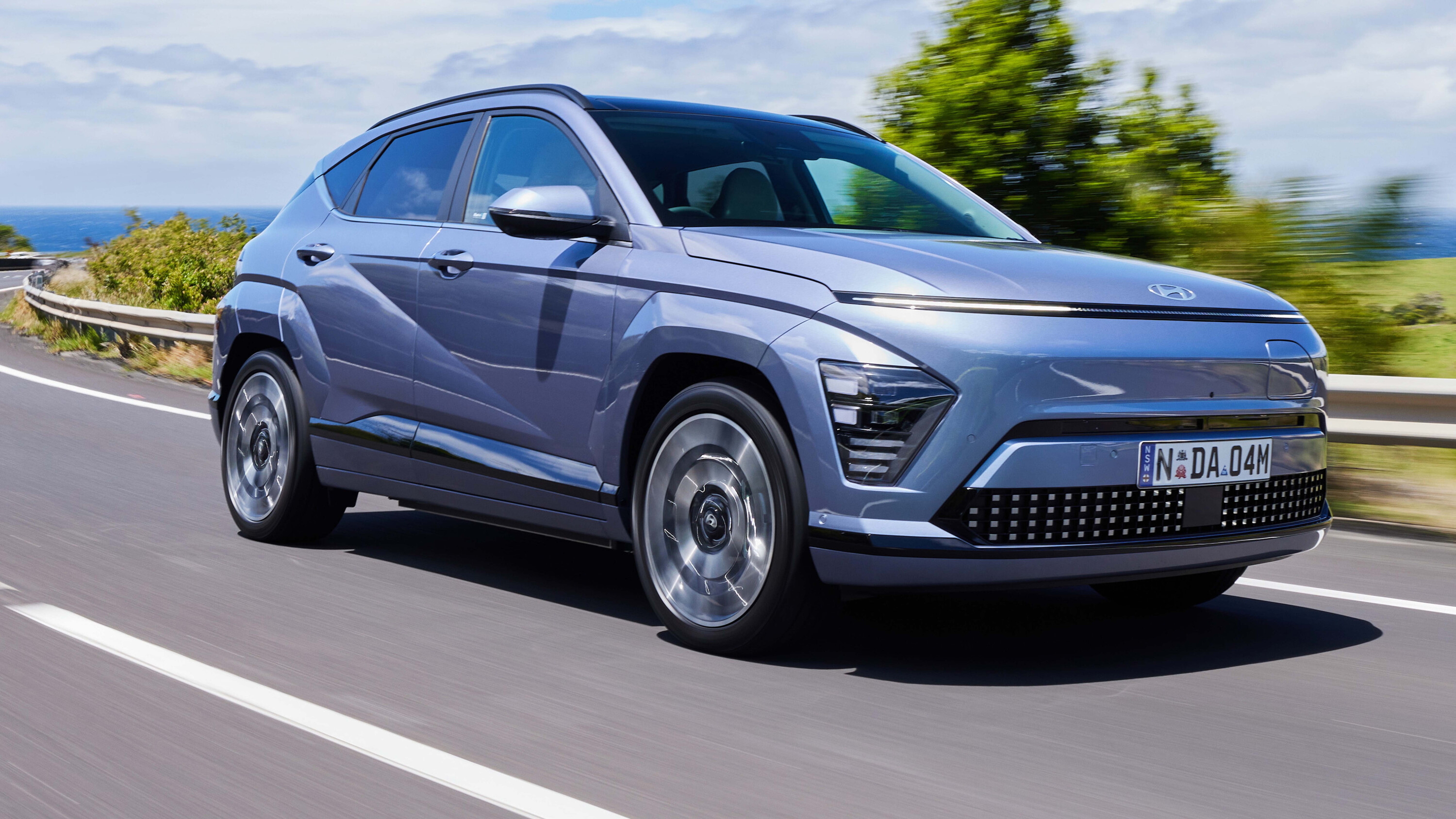Score breakdown
Things we like
- Strong equipment, safety and features list
- Spacious, comfortable & functional cabin
- Decent boot space & storage spots in the cabin
- Good ride & comfort
Not so much
- A lot of hard plastics in the cabin, no trendy recycled materials
- Like all ‘affordable’ EVs, slow charging speed will be a bother on road trips
- 4-star ANCAP rating not a great look
Hyundai’s new electric Kona is here, finally, and it presents as a more thought-provoking option than any would’ve thought when I first drove it way back in November 2023.
At that time, Hyundai still hadn’t landed on a price for the new Kona Electric, and a safety rating had also not been awarded. We now have both, and boy, what a pickle. Let’s talk about it.
Pricing: $54,000 before on-road costs.
The price? Strong. I had felt it would need to land from around $55,000 in order to be competitive with the popular $48,000 BYD Atto 3 – and ideally even less than $55k.
They’ve managed that, announcing in early January that the 2024 Kona Electric is priced from $54,000 before on-road costs, and that’s actually $500 cheaper than the smaller, less advanced previous model. Frankly, that’s a rare event, and Hyundai deserves kudos for understanding the size of the challenge before it.
Safety: Strong, but the optics…
Now we come to safety. We’d expected a five-star rating, and the tone from Hyundai suggested they did as well.
Instead, it’s a four-star rating – one that, in Europe, came with a savage rebuke: “[The Kona] scrapes by with four stars – in reality [it is] lucky to avoid three stars.”
Euro NCAP’s disappointment likely lies in what it has largely described as a ‘bare minimum’ effort from many carmakers when it comes to active safety systems.
In reality, the Kona range missed out on five stars in Australia because it is missing AEB junction crossing assist – the system that detects vehicles approaching an intersection at a perpendicular angle to the Kona.
Everything else is there, and the Kona also passed all impact tests, achieving scores equivalent to a five-star result in the categories of occupant protection in the event of a crash.
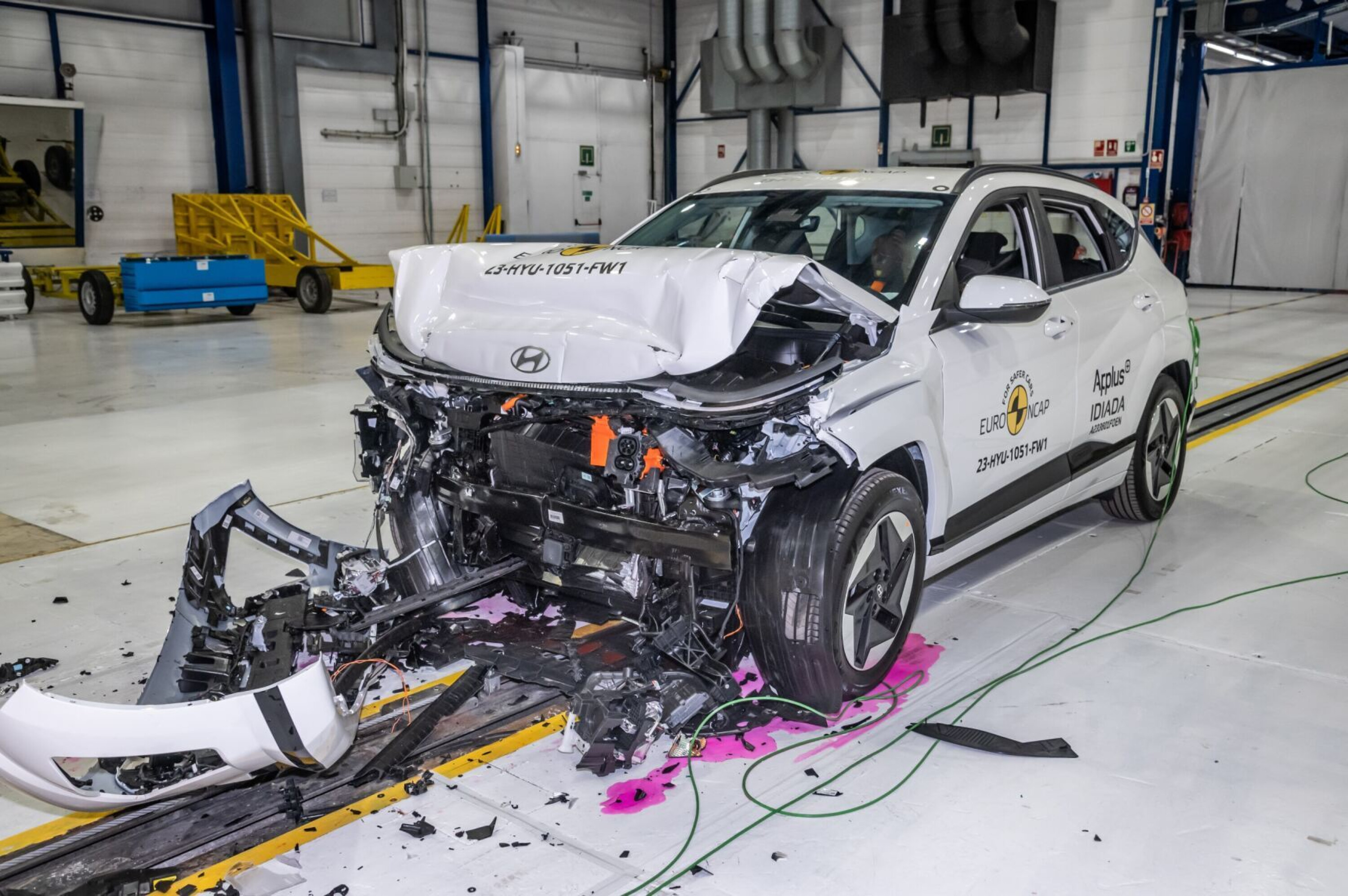
So, that’s the pricing and ANCAP story – details that weren’t available when I started on this review in November, and indeed they’re missing from the printed version of this story, sent to print in early December. A collector’s item!
What it means for Hyundai is that they can’t brag. They’re short a key marketing ingredient. A four-star score is good, but in a world of short attention spans, the Kona’s key rivals can loudly proclaim five-star safety, and Hyundai can’t.
Storm in a teacup? For many buyers, probably. With a four-star rating, the Kona joins the new Honda HR-V, new BMW i4, new Grand Cherokee, new Peugeot 308, new Citroen C4 and new Fiat 500e – along with a couple of Opel models tested for New Zealand.
Ultimately, it’s buyer’s choice, but you’d hardly be buying a death trap. As a parent myself, the Kona’s ANCAP result wouldn’t deter me.
Now, on with the review I wrote in November, revised to take in the above new information.
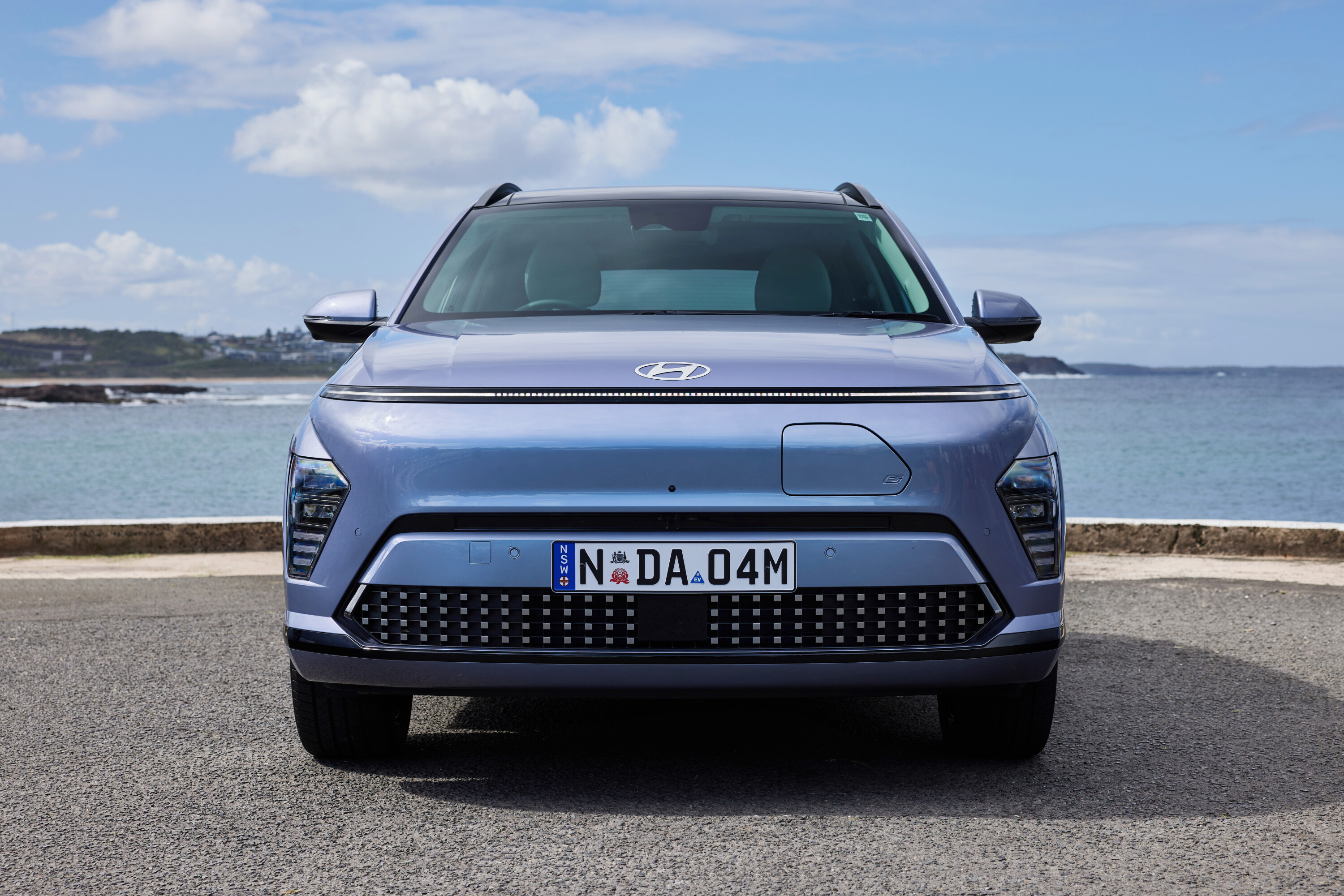
2024 Hyundai Kona Electric review: Australian first drive
If the price is wrong, interest in the latest electric Korean could be swept away by China’s already successful BYD Atto 3 – along with the smaller, cheaper but just as compelling BYD Dolphin, MG 4 and GWM Ora.
Strike that. Even for budget-focused buyers, interest in the new Kona Electric would be more than warranted.
Don’t misunderstand: Whatever the Atto 3, BYD Dolphin, MG 4 and GWM Ora might lack in polish or prestige, they each present a strong value argument for dollar-driven Aussies. The Atto 3 in particular is very popular.
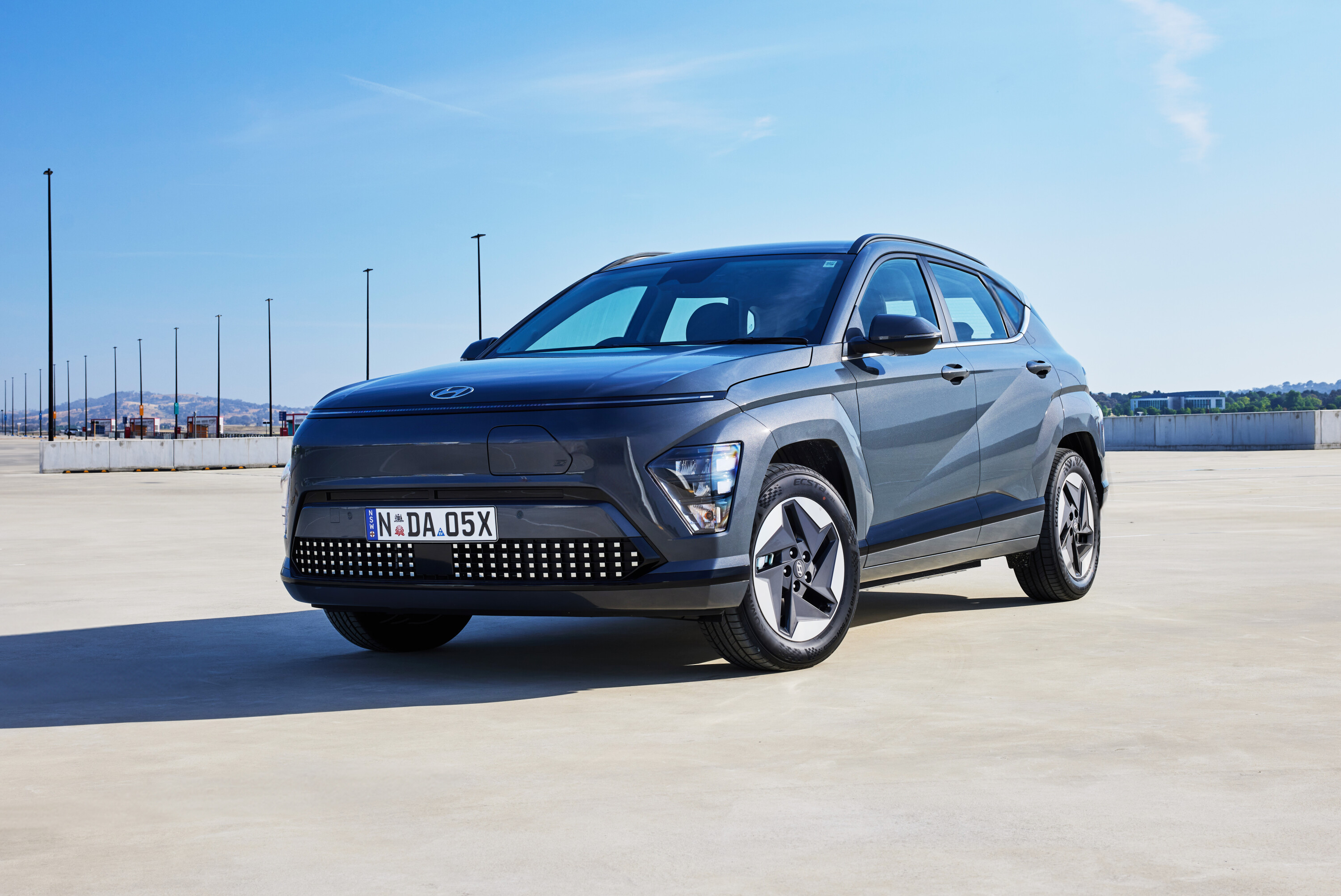
Hyundai is all too aware of that risk, and it shows. Unlike many Euro brands (so it seems), Hyundai isn’t here to be forgotten.
As I noted in the fresh opener of this story, the Kona Electric is very likely priced below where they would’ve otherwise put it – even despite the fact that bigger and more advanced Ioniq 5 now starts from just $65k.
Like any other product, but more so because of the sheer size of the spend, so much of a vehicle’s assessment and appeal comes down to its price. “Great value”, “not bad for the money”, and “I expected more for the asking price” all roll off the tongue when weighing a purchase decision.
Hyundai’s Australian arm told us at the launch event that it was working with Korean HQ to get the numbers right, which sounds a lot like it’s more worried than its global leadership when it comes to competitive pricing in our crowded market – and that many Australians are drawn to a price tag well before they think about quality and features.
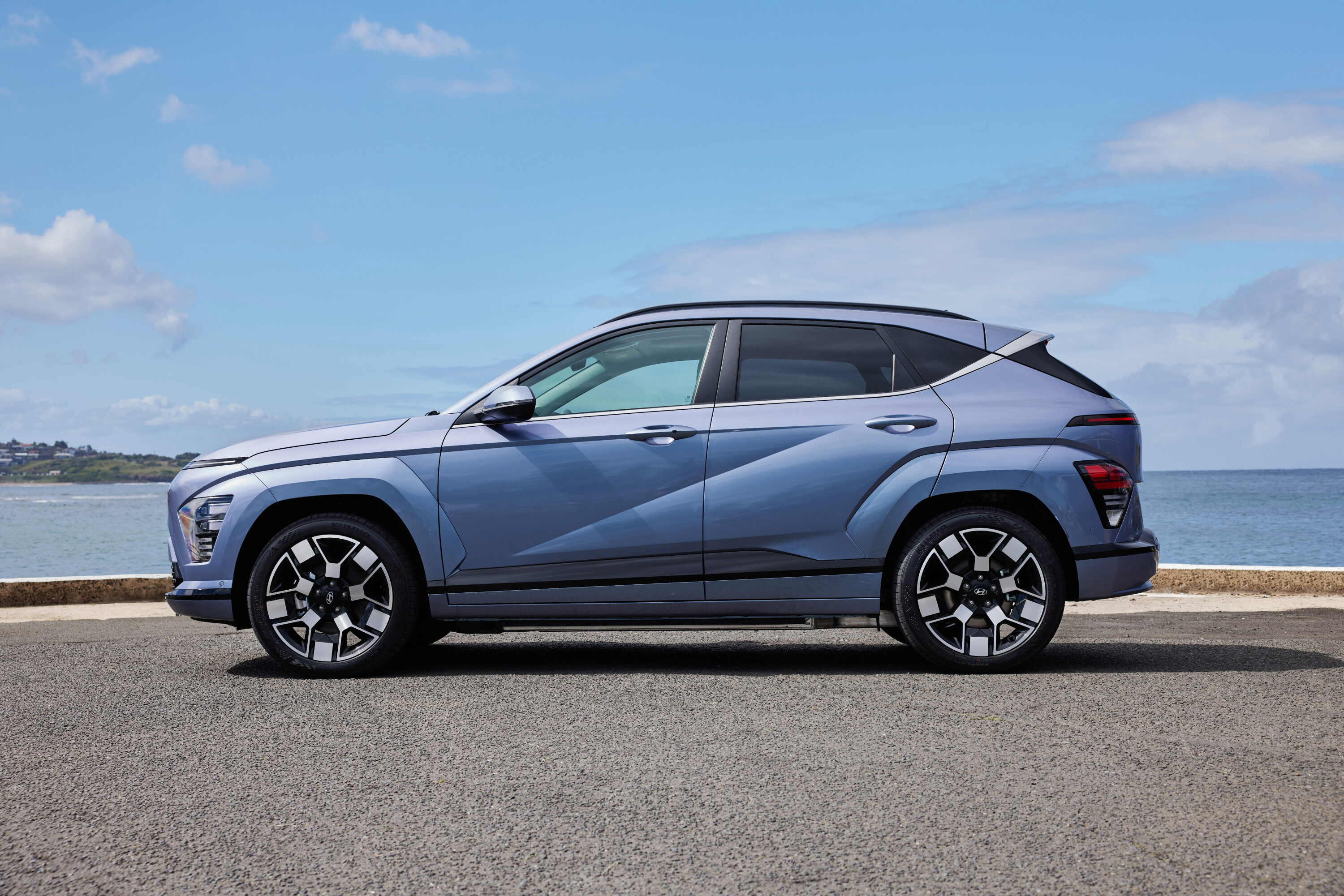
JUMP AHEAD
- How much is it, and what do you get?
- Interior quality, comfort, space and storage
- 2024 Hyundai Kona Electric boot space
- Technology in the cabin
- What is it like to drive?
- How is it on fuel?
- How safe is it?
- 2024 Kona Electric warranty and running costs
- VERDICT
- Specifications
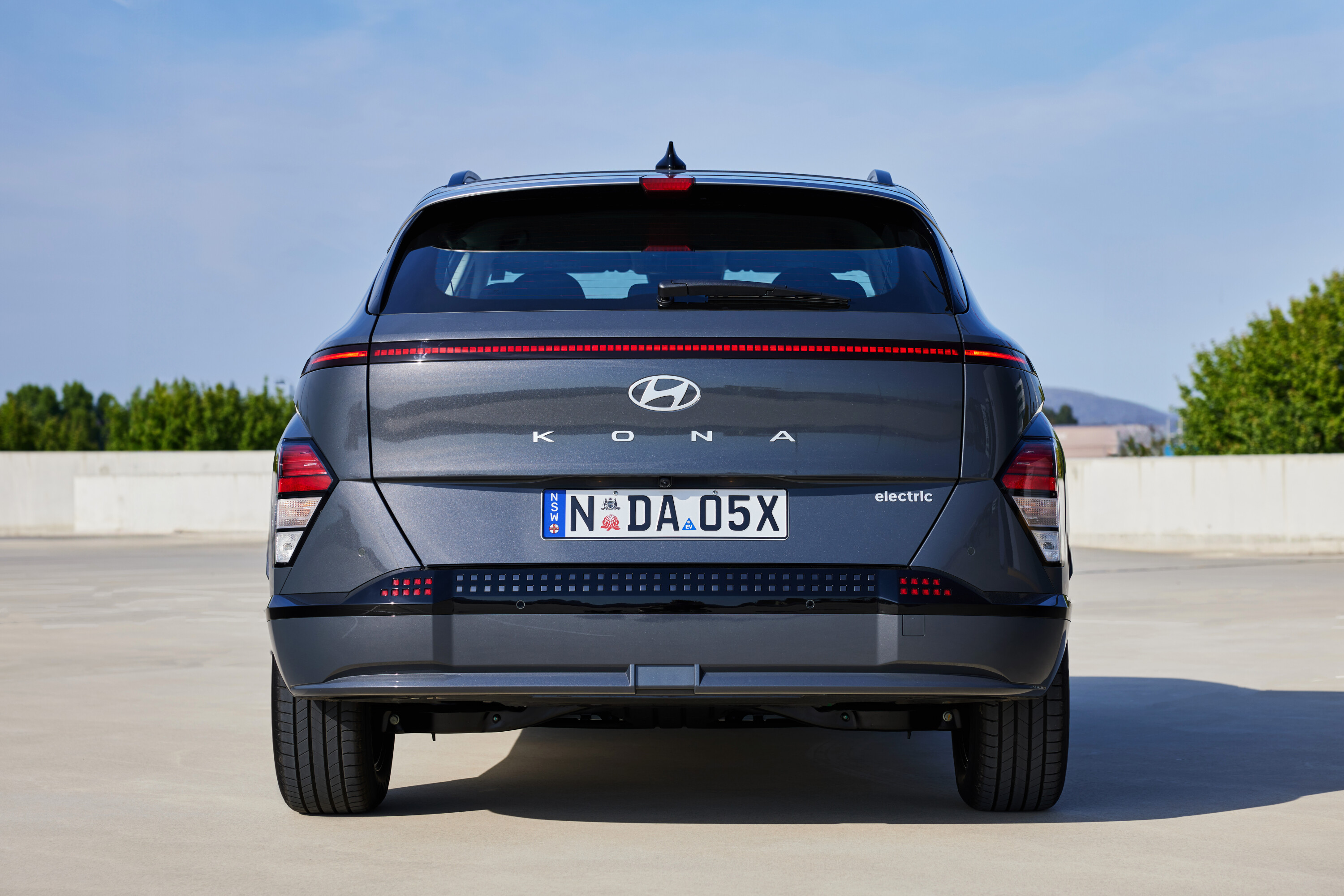
How much is it, and what do you get?
The 2024 Hyundai Kona electric starts from $54,000.
That’s a sharp price for an EV from any legacy brand, which Hyundai now qualifies as, but it’s even better when you consider what came before it: A smaller, less feature-packed runabout that cost $54,500.
Even better is that the Extended Range model is a full $2500 cheaper than its equivalent spec in the previous range.
| 2024 Hyundai Kona Electric: Key features | |
|---|---|
| 17-inch alloy wheels | Electrochromatic rear-view mirror |
| Forward Collision-Avoidance Assist 2.0 | Rain Sensing wipers |
| 12.3-inch Instrument Cluster | Wired Apple CarPlay/Android Auto (wireless coming late 2023 / early 2024) |
| Navigation + live traffic | Dual-zone climate control |
| Voice Control | Temporary space-saver wheel |
There are effectively three configurations of the Kona Electric.
The base Kona Electric Standard Range comes with a 48.6kWh battery pack, 99kW/255Nm motor and front-wheel drive, followed by a base Kona Electric Extended Range with 64.8kWh battery, 150kW/255Nm motor and again front-wheel drive.
The line-up is led, for now at least, by the Kona Premium Electric – Extended Range only. The base variants ride on 17-inch wheels and the Premium gets 19s.

? Even in sans-suffix Kona form, the Kona Electric is very well appointed.
It gets dual 12.3-inch displays in the cabin for suitable wow factor, along with Bluelink connected services with over-the-air updates, plus dual-zone climate control, integrated navigation and live traffic, rain-sensing wipers, LED lighting at both ends, an interior ‘vehicle to load’ (V2L) power outlet, heat-pump cabin heating, batter conditioning, a wireless phone charger and wired Apple Carplay and Android (wireless is promised to come as an update soon).
The entry model rolls on 17-inch alloy wheels and – get this, dear reader – a temporary spacesaver wheel is included. No ‘can of goo’ and compressor here! What a time to be alive, seeing a spare wheel as a rare treat…
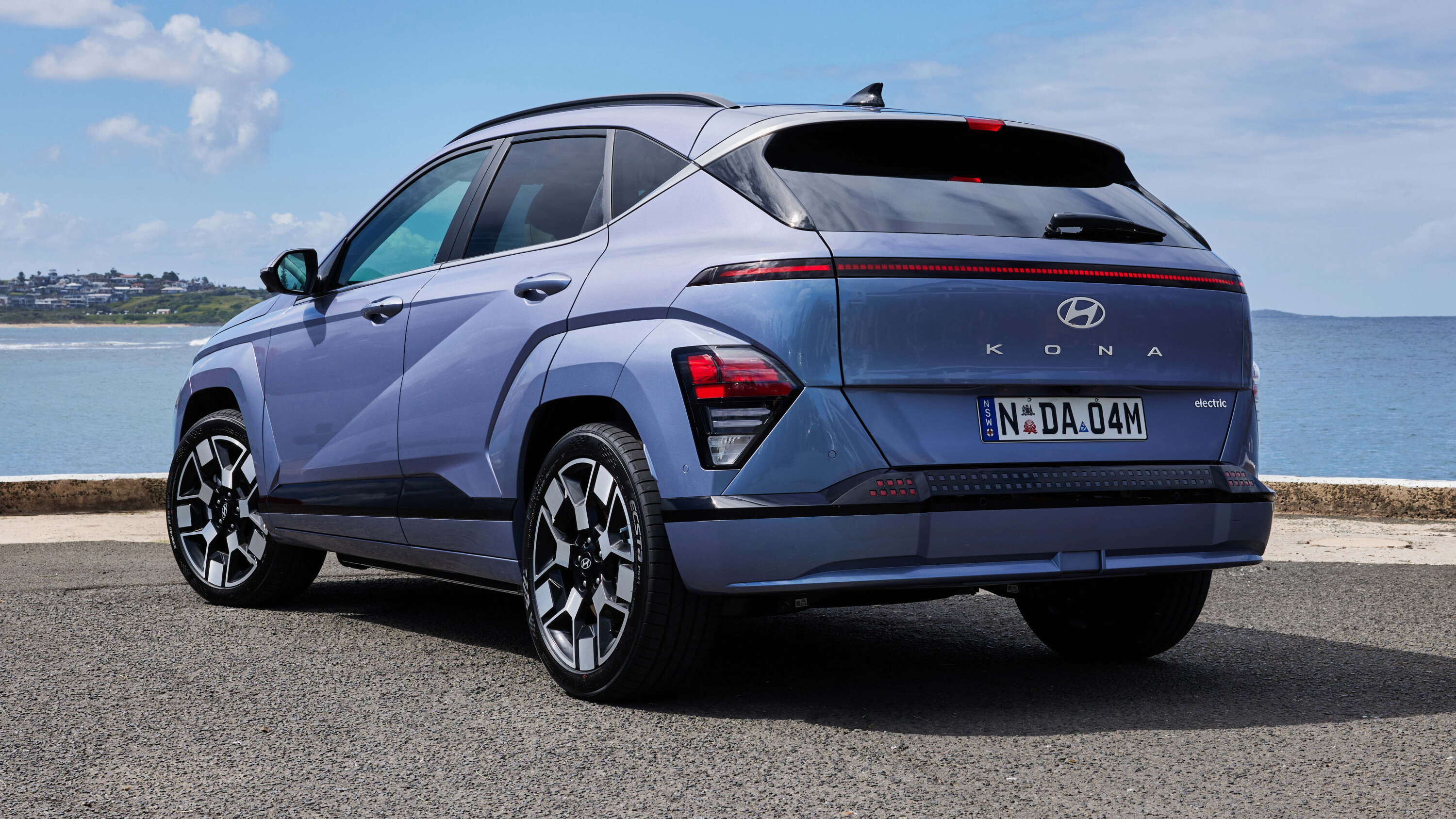
? Stepping up to the Kona Premium Electric…
…adds 19-inch alloys, ‘leather’ trim (combination leather and synthetic), powered/heated/ventilated seating, a heated steering wheel, head-up display, Bose eight-speaker audio, Remote Smart Parking Assist (RSPA), a wide glass sunroof, and a powered tailgate.
The Extended Range options also come with an official 750kg braked tow rating with a max tow-ball weight of 100kg, but the Standard Range has no official rating.
Hyundai’s SmartSense safety suite is also featured in both trim grades, detailed further down in the safety section of this story.
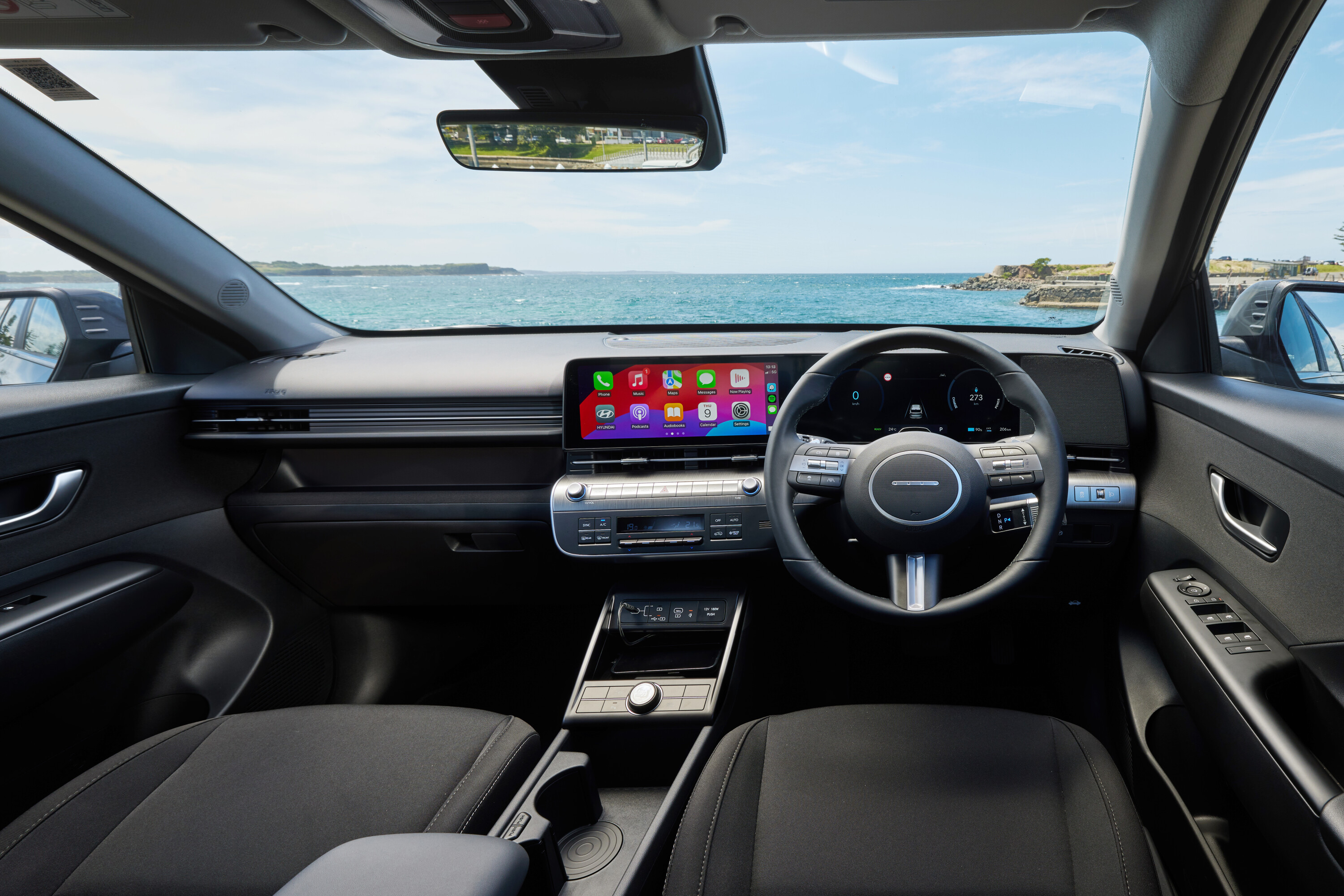
Interior quality, comfort, space and storage
Although short on soft-touch surfaces, the new Kona’s cabin is a pleasant and well-configured home on the road.
Stepping into the new Kona Electric, you’re immediately greeted with a modern and sensible design. The bright, fast and huge 12.3-inch screens tell you, irrationally or not, that you’ve spent wisely. Even better, the steering wheel and dash wear a familiar range of critical function and convenience controls, which – in this age of cost-cutting under the guise of style and simplicity – is feeling more and more like a rarity.
Unlike the first-generation Kona, this new model was developed as a properly practical small SUV on the large end of the segment, its longer wheelbase well-suited to carrying a family of four in better than reasonable comfort.
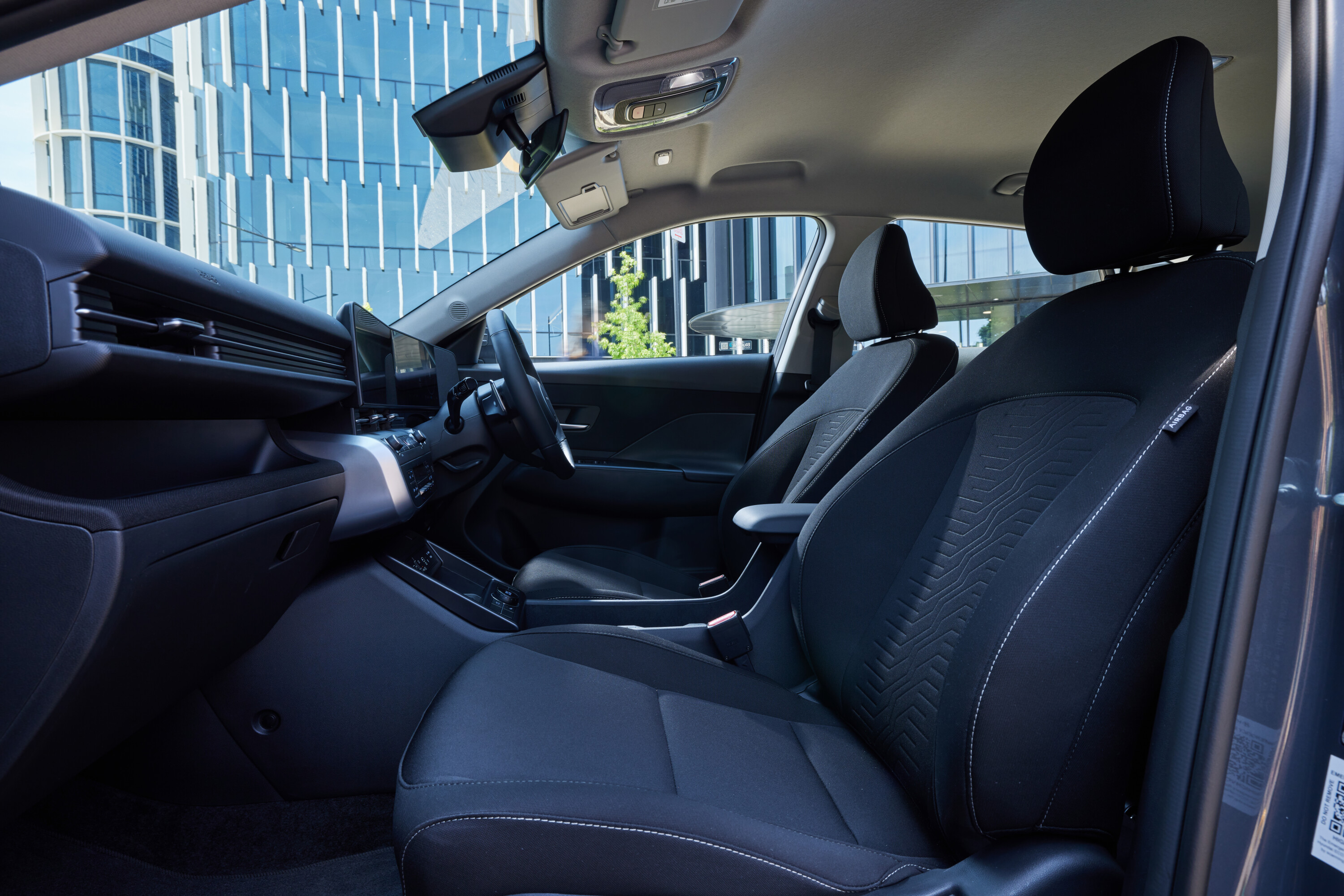
The new Kona shares its platform with the i30 Sedan and Kia Niro, but its dimensions differ somewhat, with a wheelbase of 2660 millimetres – 60mm longer than before, but still 60mm shorter than the related vehicles.
Overall length grows by 150mm to 4355mm, and width is up 25mm to a new 1825mm. Hyundai says this results in a second row that offers 77mm more legroom and 11mm greater headroom, making it a segment leader in these dimensions.
For context, the popular Toyota Corolla Cross rides on a 2640mm (-20mm) wheelbase and measures 4460mm in overall length (+105mm), with an identical 1825mm width.
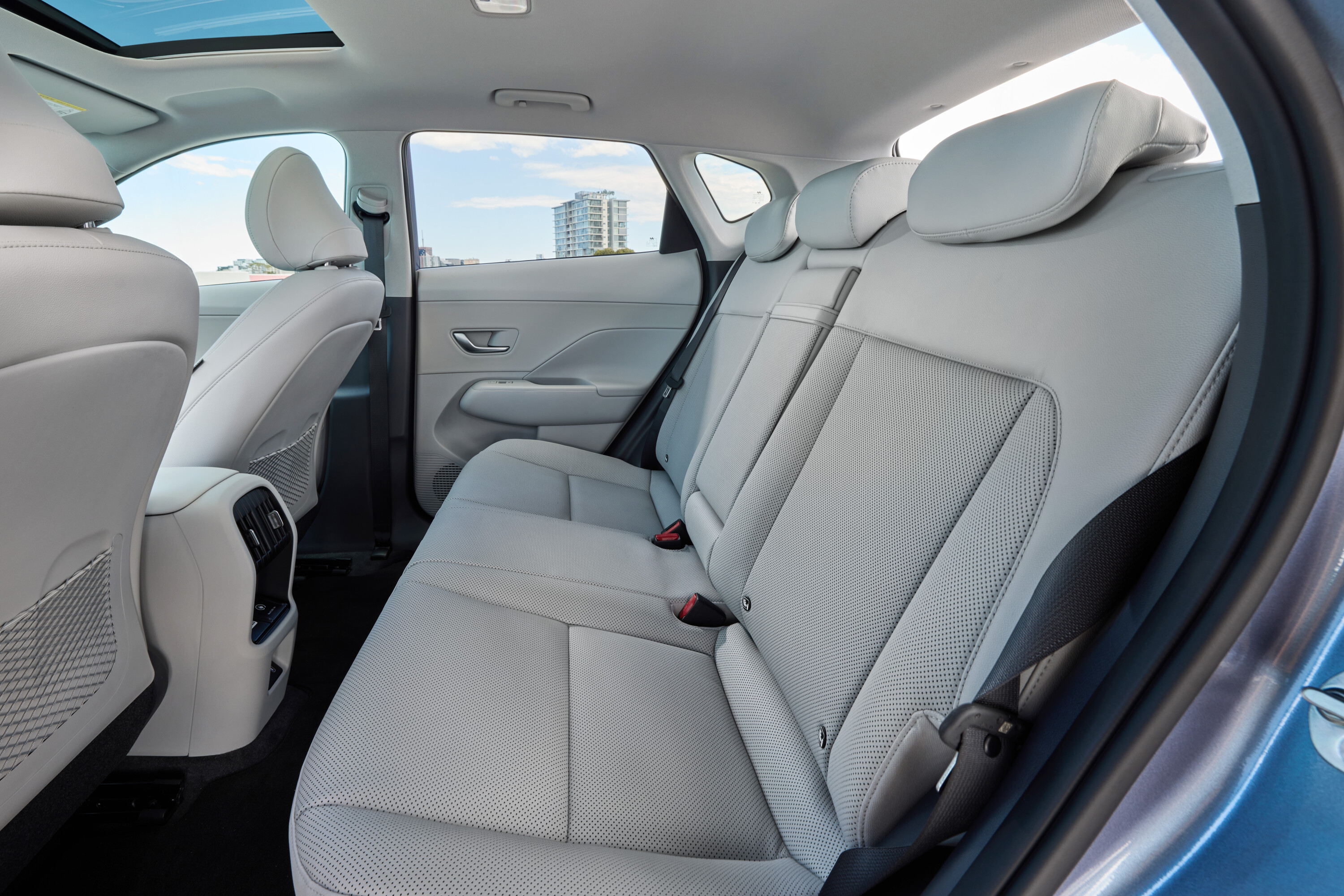
Comfort in both rows is good, with firm but supportive seats, cloth-trimmed in the entry model and ‘leather’-upholstered in the Kona Premium. Occupants in the front get well-bolstered backrests, along with a laidback “zero-gravity weightless posture” Relaxation position in the Premium to rest while charging. Owners of the entry EV model miss out on powered seats, however, with that function exclusive to the Kona Premium.
That longer wheelbase, along with scalloped front seatbacks and a flat rear bench, means adults in the second row have fairly generous leg and knee space. Toe room under the front seats is likewise good, while the flat floor means any middle passenger will only be squashed from the hips up. Take your victories where you can get them… and the rear seats recline, too.
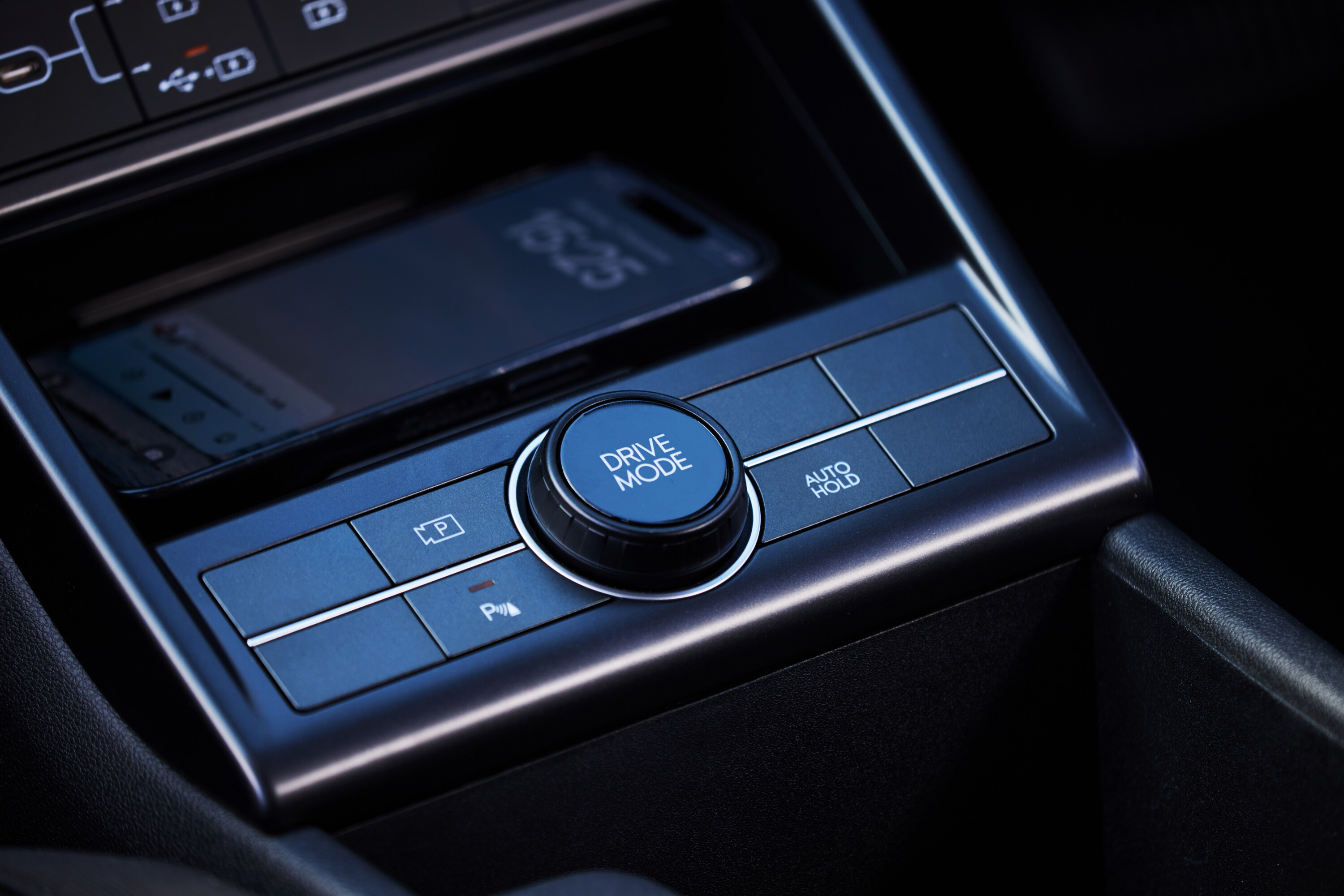
Storage in the Kona’s cabin is plentiful. The front row offers a cubby beneath the HVAC controls for 15W fast and cooled wireless phone charging or bits-and-pieces, while the cup-holder rings can be retracted to create a large open storage area – thanks in great part to the gear shifter moving to a column behind the steering wheel. The centre console has no deep closed cubby, however, and lifting the armrest reveals only more open space.
There’s a long slim bench above the glove box, although its hard-plastic surface makes it fairly useless for storing anything while driving. The glovebox itself is deep, however, and the door bins are likewise large with plenty of space for a one-litre drink bottle and other items besides.
Occupants in the second row get a pair of small cup-holders in the fold-down centre arm rest, decent door bins and a map holder in the front seatbacks.
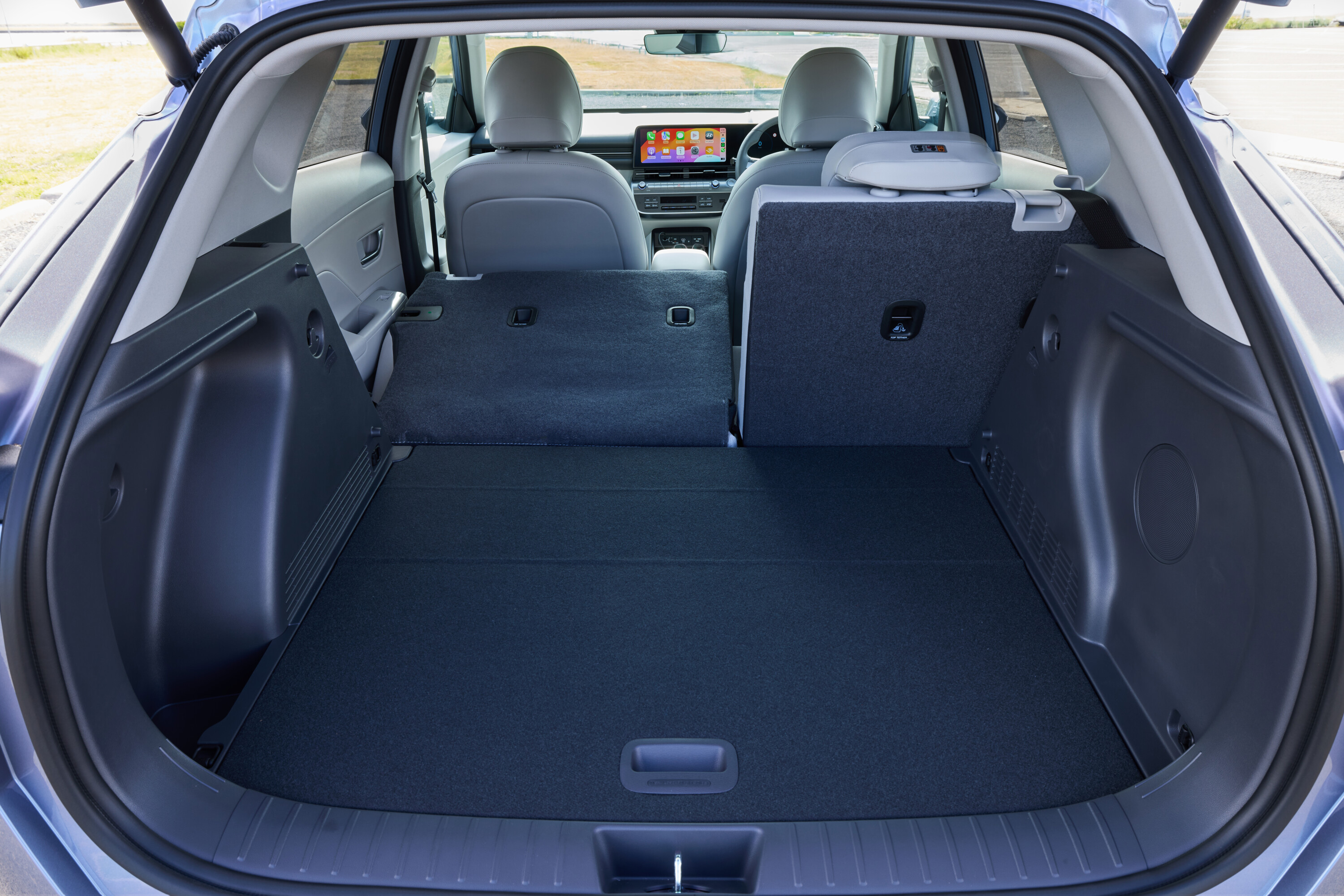
2024 Hyundai Kona Electric boot space
The new Kona Electric offers a decent 407 litres of boot space with the 60:40-split folding rear seats upright, expanding to 1241 litres when laid flat.
This area is a touch smaller than most rivals in the small-SUV segment, but Hyundai is eager to remind that its second-row legroom is best in class, and the EV’s rear space is identical to that of the petrol model – meaning there is little compromise in opting for electric over combustion.
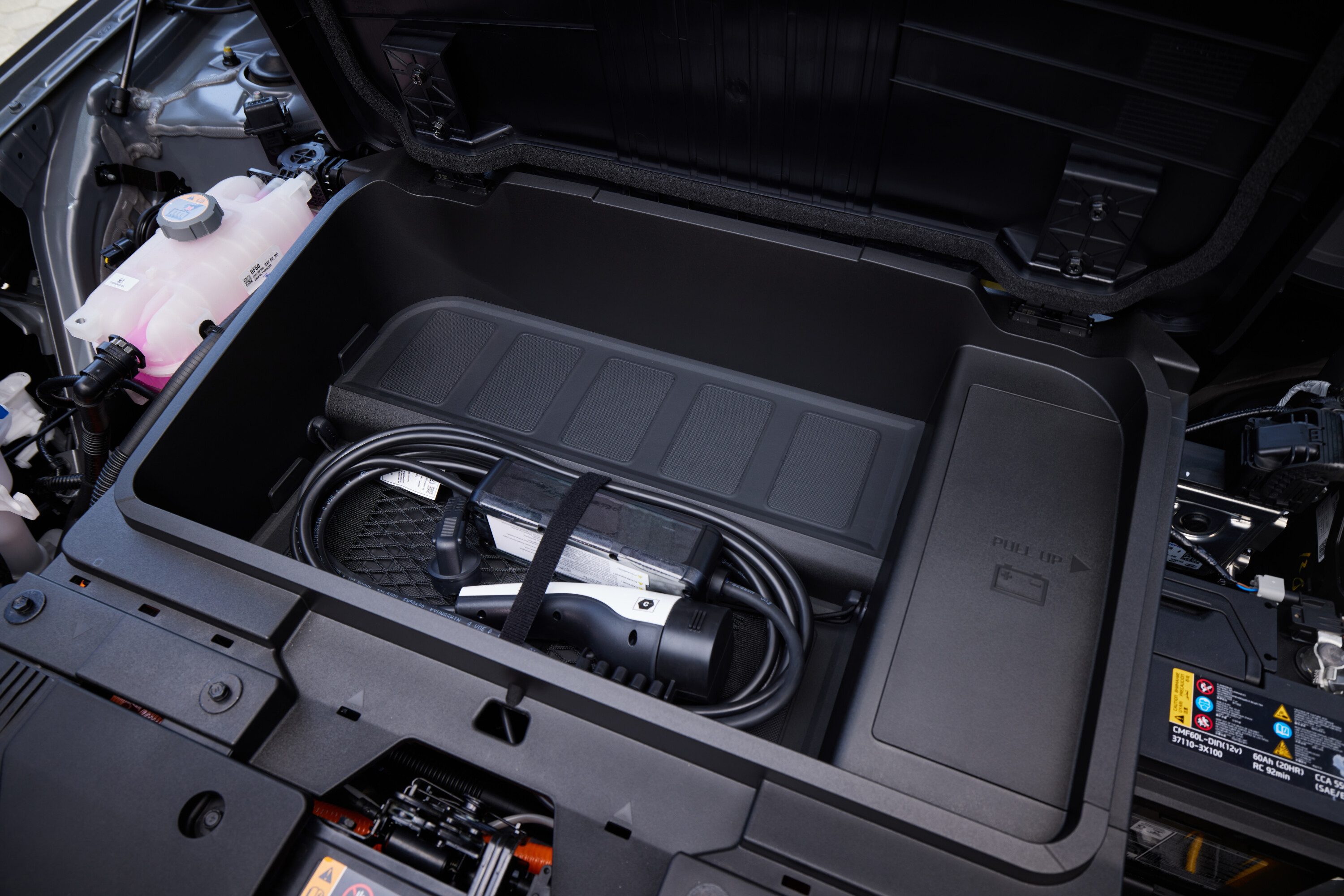
Access to the boot is also made easier than in the previous model, thanks to a wider opening and a lower lip at the floor.
There’s also a 27-litre storage area under the bonnet – room enough to store the charging cable, shoes, wet gear or a small backpack.

Mini matchup: Boot space
| MODEL | WHEELBASE | BOOT (litres) |
|---|---|---|
| Hyundai Kona (all) | 2660mm | 407 / 1241 |
| Kia Niro EV | 2720mm | 425 / 1392 |
| BYD Atto 3 | 2720mm | 440 / 1340 |
| MG 4 | 2705mm | 350 / 1117 |
| Toyota Corolla Cross | 2640mm | 414 / N/A |
| Kia Seltos | 2630mm | 433 / 1393 |
| Mazda CX-30 | 2655mm | 317 / N/A |
| Nissan Qashqai | 2665mm | 429 / 1425 |
Technology in the cabin
Hyundai has come a long way with its in-car technology, with an infotainment system now comfortably at the head of the class for feature richness, simplicity and power.
The new system boasts four times the computing power and 15 times the display processing power of Hyundai’s previous system, seen in the current Tucson and Santa Fe among others. The specifics of that are irrelevant to most users, except to say that touching and typing on the display feels like using a high-end Apple or Android tablet, with rapid responses to input and speedy transitions between pages.
Controls for the Kona’s most frequently used features are almost all physical switches and dials, including the HVAC, media, cruise control and camera controls.
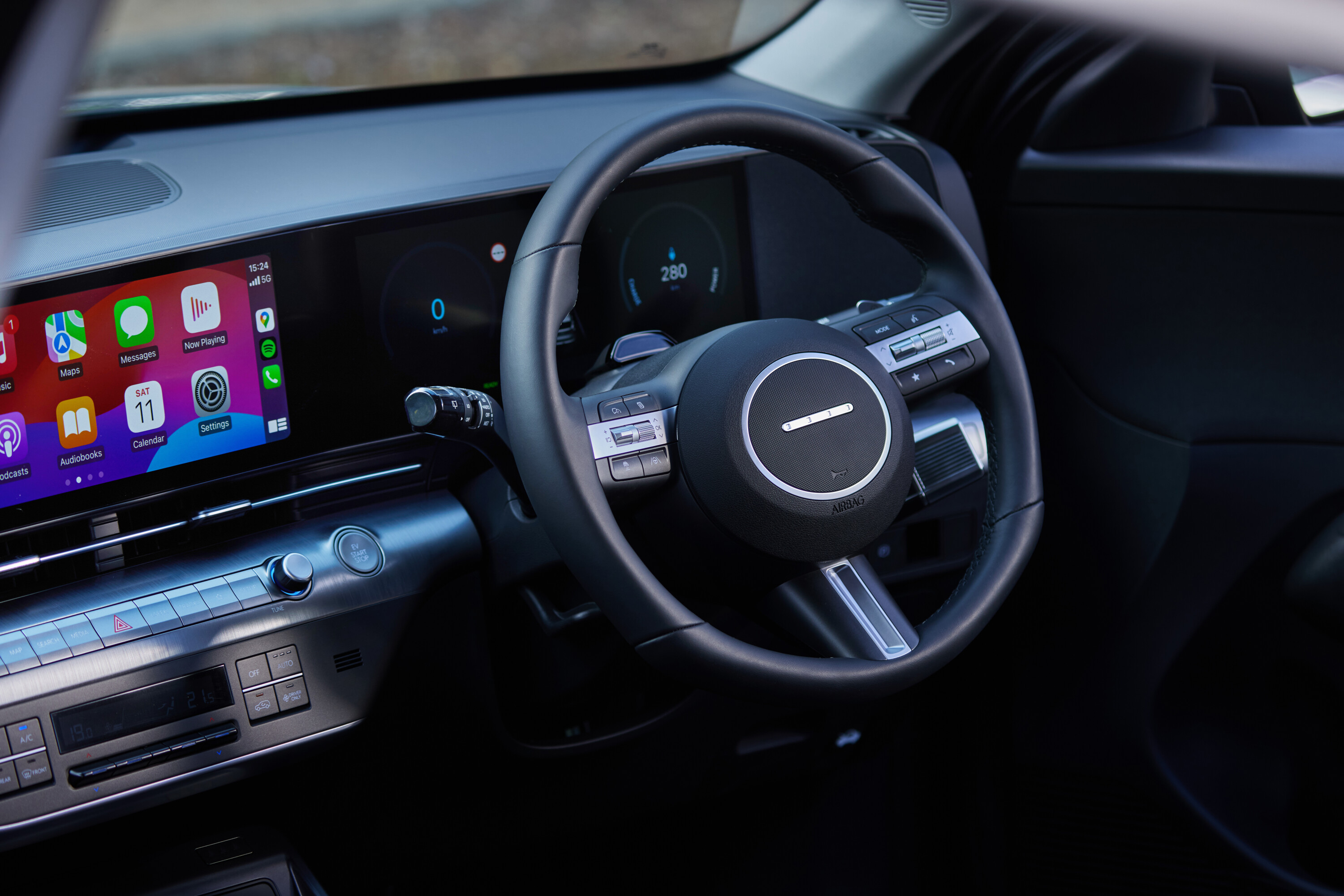
Hyundai’s Bluelink connected services platform is also featured, allowing remote status monitoring and control of key features like charging times and limits, door locks, windows, climate control, lights, horn, and trip planning. In this latest generation, Bluelink also enables over-the-air updates for safety, braking, performance, driver assist and mapping.
Both rows get 27W/3A rapid-charge USB-C charging ports, while the second row also has a V2L outlet for powering thirstier devices like a laptop or, if you’re inclined, a coffee machine.
Apple CarPlay and Android Auto are both featured and operate smoothly, but for now they remain a wired feature. Hyundai says it has a vehicle in Australia right now, testing with wireless connectivity, and hopes to roll out an OTA update in the coming weeks or months.

What is it like to drive?
There’s little hiding the Kona Electric’s weight if you enjoy spirited driving, but most of the time you’d scarcely notice.
With its larger design and big floor-mounted battery packs pushing it to a new 1690kg kerb weight in Standard Range form, compared to the previous Kona Electric’s 1535kg – and the 1335kg weight of the regular new petrol Kona – this latest EV is indeed a hefty one. Again, some context: the VE Commodore, in its standard form, also weighed 1690kg.
Hyundai’s drive route through regional Canberra took in plenty of winding roads, which is where you’ll most easily notice the Kona Electric’s weight as its traction system and you at the wheel work to combat physics. There’s not a lot in it, though, and being noticeable isn’t the same as being concerning – especially with the helpful regenerative braking system, allowing you to slow your entry into corners without touching the brake pedal.
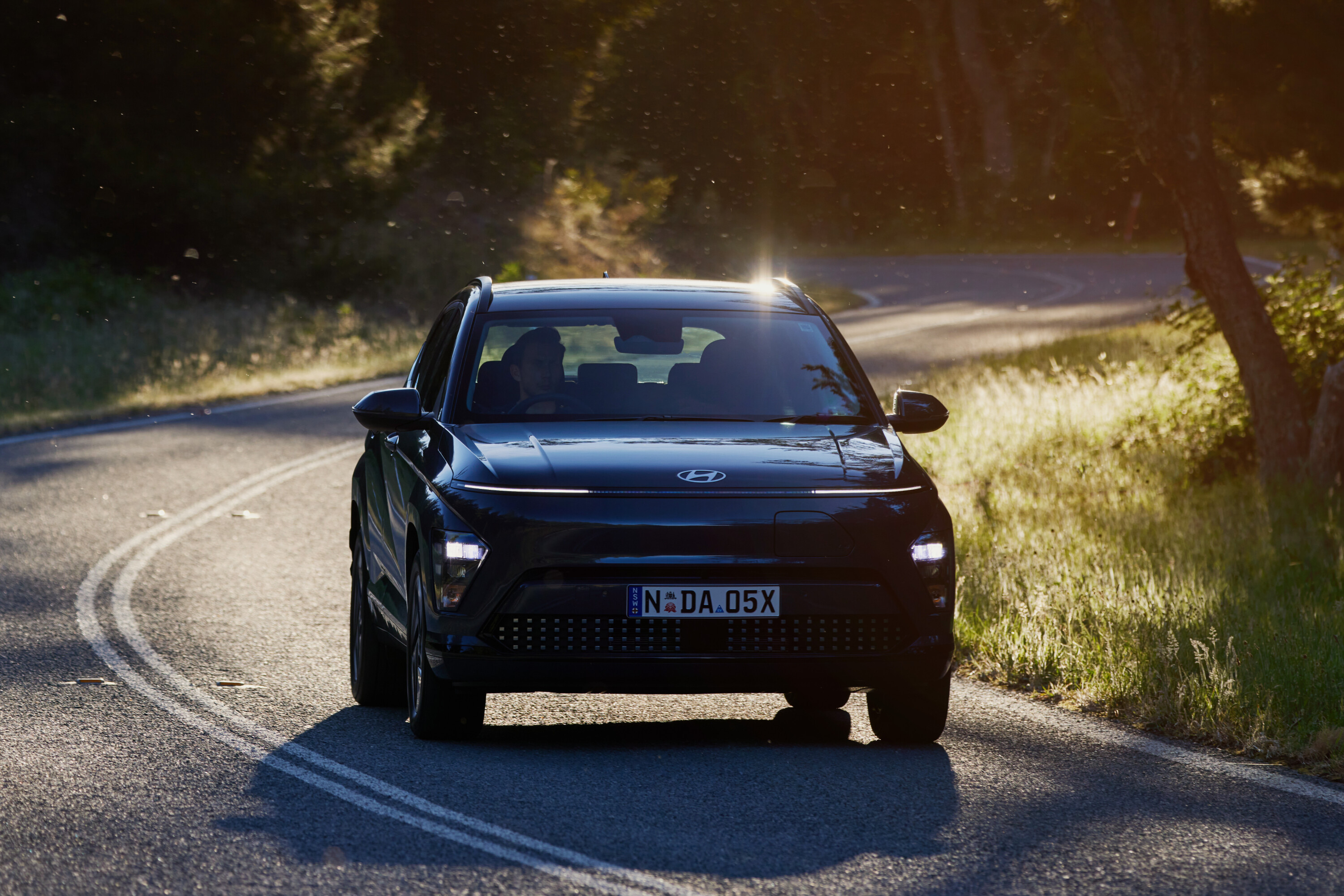
Of course, the Kona Electric wasn’t designed to be driven in anger, and with most buyers it never will be. Ride and comfort is overall good in the entry model, with its region-specific (but not Australian-tuned) suspension package and 17-inch wheels wrapped in a thick 60-profile Kumho rubber helping it maintain composure across most surfaces.
The Premium’s 19-inch wheels and 45-profile tyres sacrifice some of this comfort for style points, but not by much – and it does look the business in that higher spec.
Steering is responsive and accurate in turns, with a good and confident straight-ahead feel on the highway. Enthusiasts will lament the lack of feedback, but this is increasingly common in newer cars with electric steering, and not something most motorists will detect.

Acceleration is delivered quickly without unleashing too much torque off the line (there isn’t loads on offer anyway), while braking is strong and easily modulated with good top-of-pedal feel. Brake regeneration is also on board to reduce reliance on the brake pedal while also feeding energy back into the battery, and the highest level – i-pedal –can just about completely cut the brake pedal out of the picture, once you get used to it.
Wind and road noise, a more prominent companion with the otherwise silent motoring in electric vehicles, is well enough damped and seems no worse than with other affordable-end EVs. Only a back-to-back test would say for certain, but upgrading to higher-quality tyres on your first replacement would only help.
If any of the terms in this section have left you scratching your head, these articles will help bring you up to speed!
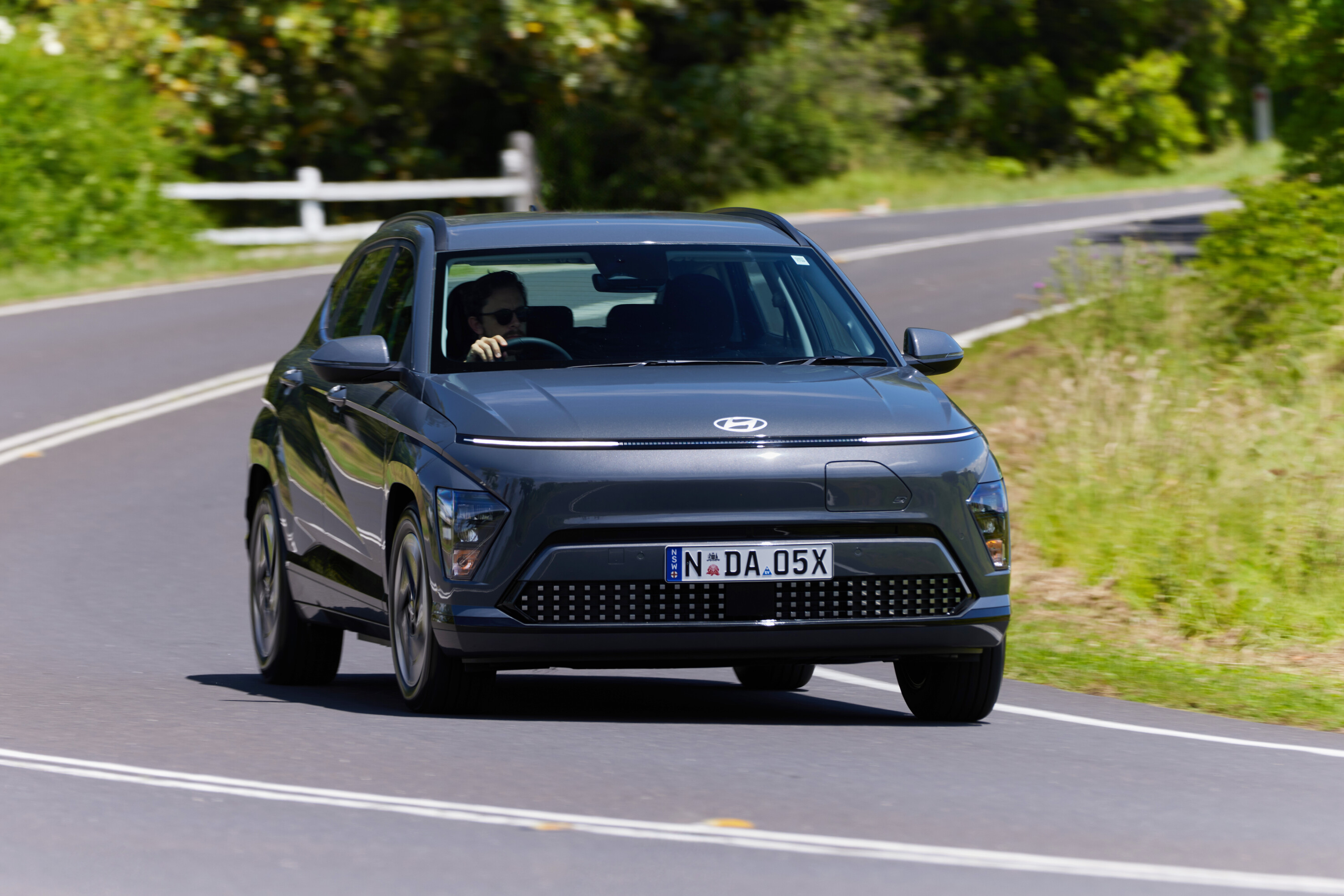
- What is a Powertrain or Drivetrain?
- Power vs torque
- Car suspension explained
- Automatic transmissions (‘gearboxes’) explained
- Chassis control systems explained
- Car vs Ute vs SUV: How the vehicle you buy should guide the way you drive
- What is the WLTP emissions and range test?
Officially, the Kona Electric claims an efficiency rating of 14.2kWh/100km in the Standard Range, down slightly from the 14.3 of its predecessor.
Launch events are far from the ideal for a realistic measure of the claim’s accuracy, but after two hours of mixed urban, highway and spirited driving in the hills, I returned 16.8kWh/100km – suggesting the official figure should be comfortably achievable. We’ll test this further in our upcoming week-long booking. (Keep an eye on whichcar.com.au/hyundai/kona)

The Extended Range lists 14.7 on the 17-inch wheels and 16.7 on the 19s, showing what a difference can be made with wheel diameter and a slightly less luxurious fitout.
The 99kW Standard Range lists a WLTP-certified driving range of 370 kilometres, while the 150kW Extended Range lists 505km with the 17-inch wheels and 444km for the 19s.
The Kona Electric’s 400V electric system is slower than the 800V system offer with Hyundai’s more expensive EVs, resulting in a fastest-possible charging time of 10-80% in “approximately” 45 minutes on a 100kW+ DC charger. This is plenty for daily driving, but could prove frustrating on road trips – particularly when time is of the essence.
| On-board AC charger | 99 kW Electric Motor | 150kW Electric Motor |
|---|---|---|
| Charging capacity | 10.4 kW | 10.4 kW |
| Standard charging time – 240 V (10% to 100%) | Approx 5 hours 15 minutes | Approx 6 hours 35 minutes |
| Charging port | Type 2 | Type 2 |
| On-board DC fast charger | 99 kW Electric Motor | 150kW Electric Motor |
|---|---|---|
| Charging capacity | 100 kW | 100 kW |
| 50 kW fast charging time (10% to 80%) | Approx 1 hour 5 minutes | Approx 1 hour 5 minutes |
| 100 kW fast charging time (10% to 80%) | Approx 45 minutes | Approx 45 minutes |
| Charging port | CCS Combo2 | CCS Combo2 |
Mini matchup: Efficiency
| MODEL | Battery | Efficiency (claimed) | Range (claimed) |
|---|---|---|---|
| Kona Electric Standard | 48.6kWh | 14.8kWh/100km | 370km |
| Kia Niro EV S | 64.8kWh | 16.2kWh/100km | 460km |
| BYD Atto 3 Standard | 50kWh | 16kWh/100km | 320km |
| MG ZS EV Excite | 50kWh | 20.1kWh/100km | 320km |
How safe is it?
As covered above, we didn’t know at the time of testing that the Kona range would be given a four-star rating.
Why? Well, because it comes bearing strong active and crash safety credentials, with seven airbags including a front centre airbag, and a suite of advanced driver aids under the Hyundai SmartSense banner.

Key among those features is Lane-Change-Side that can manage steering during lane changes, along with Forward Attention Warning for driver monitoring, using an in-cabin infra-red camera to detect the driver’s face, head position/direction, and eye tracking/opening/closing state.
Others include blind-spot collision monitoring and avoidance, lane-keep and lane-following assist (monitoring and acting on forward vehicles and line markings), rear cross-traffic collision avoidance, and active cruise control with stop-and-go – which includes a Machine Learning (AI) system to learn the driver’s patterns and habits for tailoring its controls to their preferences.
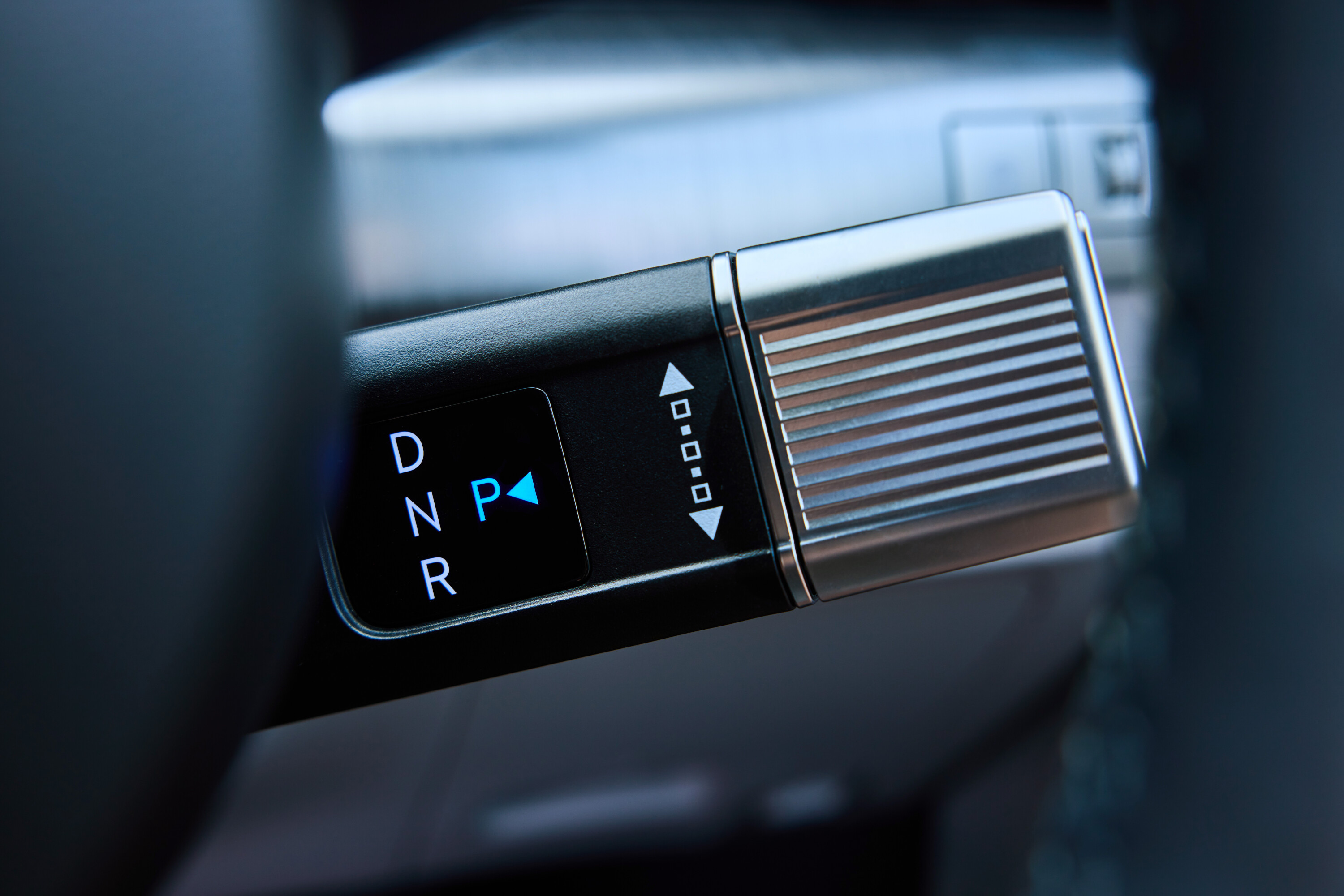
Four stars aside, damn those beeps…
A note to ANCAP & Euro NCAP: I can’t help but wonder if driving people to madly disabling alerts isn’t undoing the benefits of their intended function.
As with all cars featuring these types of systems, properly assessing their capability requires a lot of closed-road conditions – but what I can tell you is that, for whatever the extent to which these systems can protect you, they’re bloody annoying in the meantime.
With all of its active safety systems running, this Hyundai throws more beeps and boops at you in one trip than R2-D2 does in all of Episode 4 – and I can’t help but wonder if driving people to madly disabling alerts isn’t undoing the benefits of their intended function.
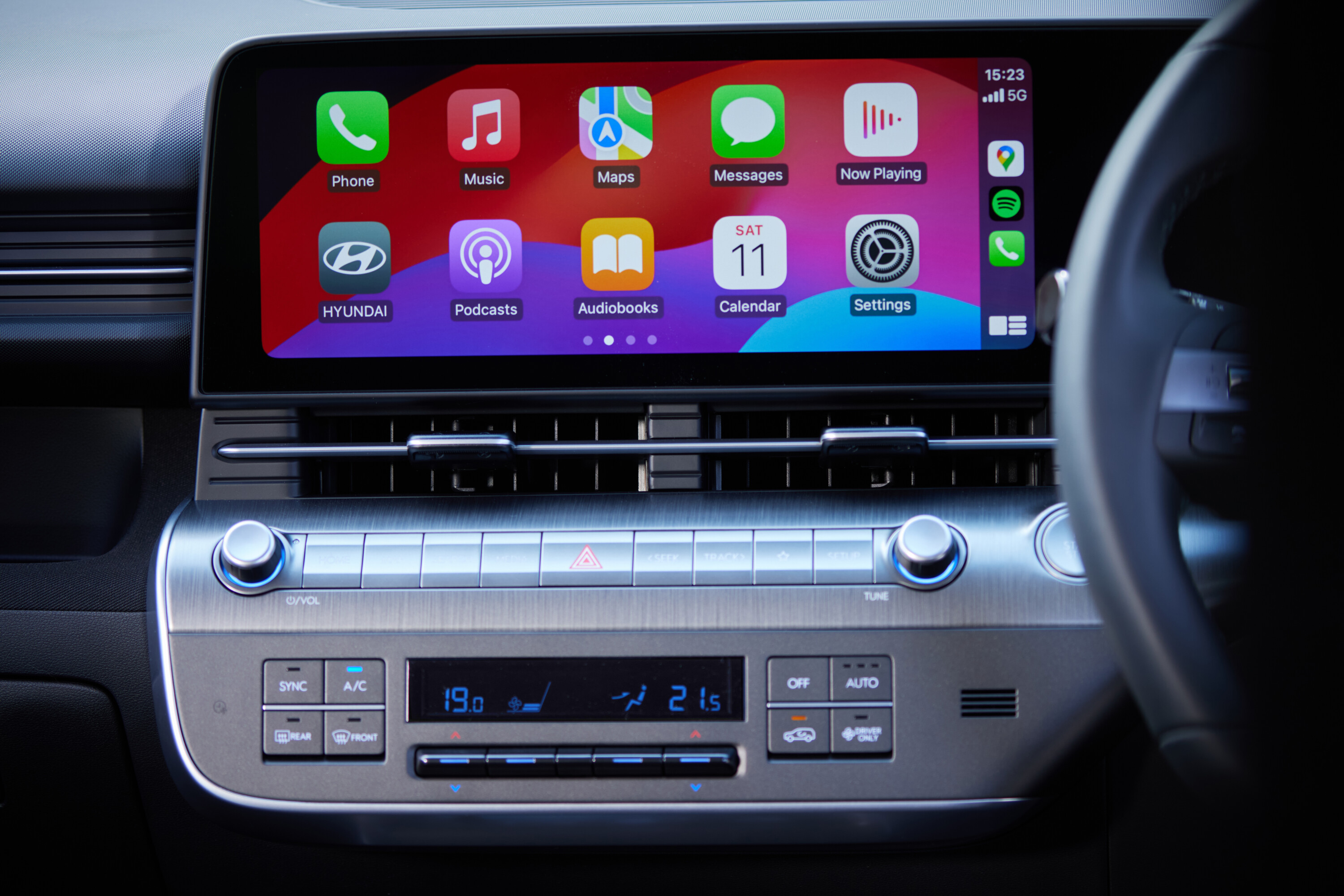
To its credit, Hyundai’s commitment to safely accessible controls and visible displays is commendable.
Where some brands – like Tesla and now Volvo with its small EX30 – aren’t bothering with a dedicated driver display or even a head-up to display, the Kona has not only its two huge 12.3-inch screens, but also a giant 12-inch head-up display. No chance of missing the speed limit or any visual alerts.
| Electronic Stability Control (ESC) including; | KONA | KONA Premium |
|---|---|---|
| Anti-lock Braking System (ABS) | u25cf | u25cf |
| Brake Assist System (BAS) | u25cf | u25cf |
| Hill-start Assist Control (HAC) | u25cf | u25cf |
| Multi Collision-Avoidance Brake (MCB) | u25cf | u25cf |
| Traction Control System (TCS) | u25cf | u25cf |
| Vehicle Stability Management (VSM) | u25cf | u25cf |
| Hyundai SmartSense including; | KONA | KONA Premium |
|---|---|---|
| Blind-Spot Collision Avoidance-Assist (BCA) | u25cf | u25cf |
| Blind-Spot View Monitor (BVM) | – | u25cf |
| Driver Attention Warning (DAW), including; | u25cf | u25cf |
| Leading Vehicle Departure Alert | u25cf | u25cf |
| Forward Attention Warning (FAW) – in-cabin camera | u25cf | u25cf |
| Forward Collision-Avoidance Assist (FCA 2.0) including: | KONA | KONA Premium |
|---|---|---|
| Car / Powered two-wheeler / Pedestrian / Cyclist detection | u25cf | u25cf |
| Direct Oncoming function (FCA – DO) | u25cf | u25cf |
| Evasive Steering Assist function (FCA – w/ESA) | u25cf | u25cf |
2024 Kona Electric warranty and running costs
The new Kona Electric is covered by Hyundai’s 5-year / unlimited-kilometre vehicle warranty and 8-year / 160,000km battery warranty.
These terms are now fairly standard for the Australian car market, with only a few offering less than unlimited kilometres, and again only a handful offering better than five years on the vehicle.
For servicing, Hyundai offers a ‘lifetime’ pricing list, which runs up to six years. Each visit will cost $520, with no big-hit ‘major service’ in the entire run. The first scheduled service is at 24 months / 30,000km, second is at 48 months / 60,000km, and third is at 72 months / 90,000km for $520.
| 2024 Hyundai Kona Electric service pricing | |
|---|---|
| Service interval | Price |
| 24-month/30,000km | $520 |
| 48-month/60,000km | $520 |
| 72-month/90,000km | $520 |
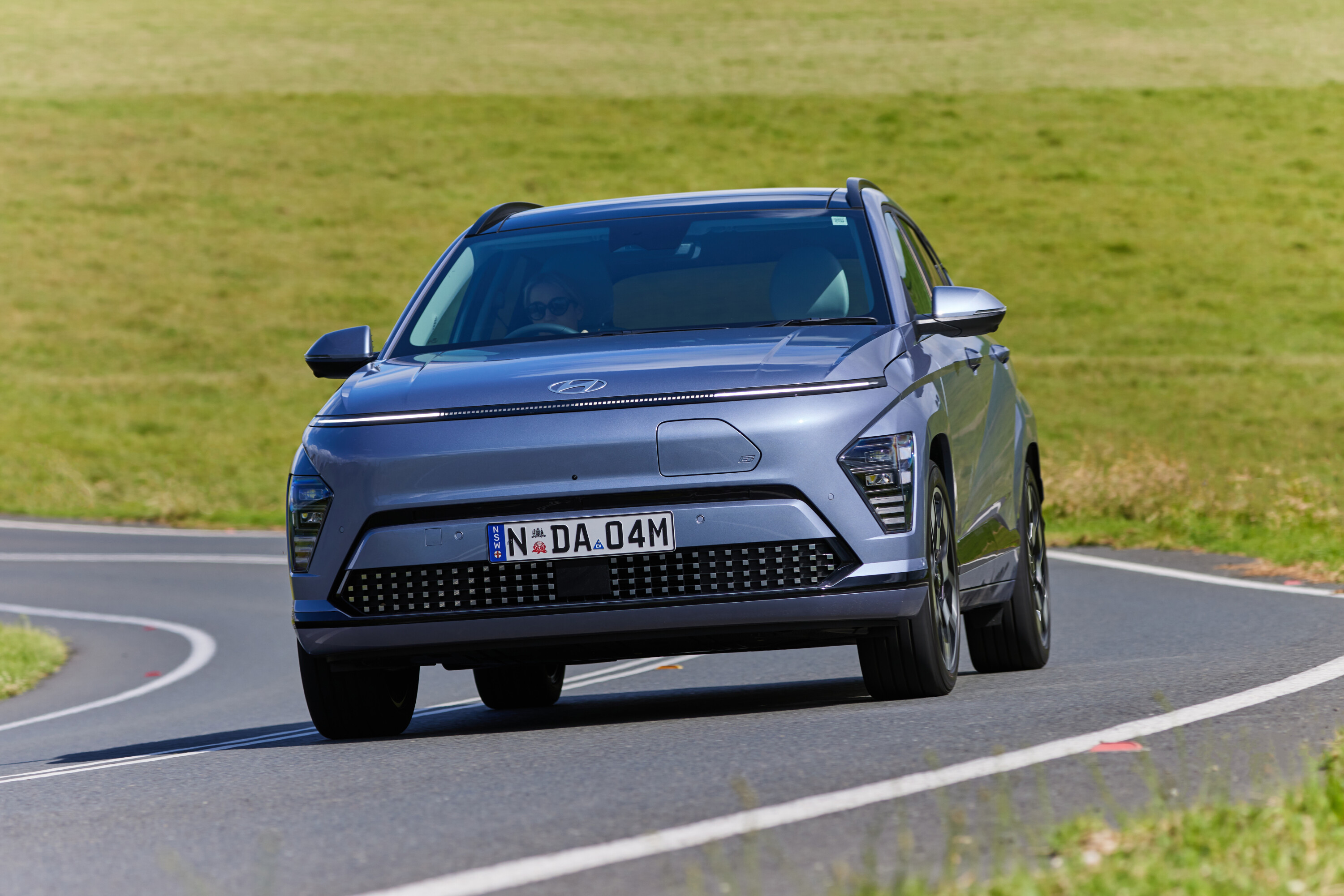
VERDICT
As with the previous Kona Electric, which was a popular offering for much of its life, there’s a lot to like with this new generation.
Line the new Kona up alongside BYD’s very popular Atto 3 and you might see the little details that make the Hyundai look and feel like a more complete package developed by a company more experienced with western markets.
The trouble is that, like wine-tasting, those little details are largely inconsequential and even undetectable for many buyers. That’s just human nature, but it could mean there may not be enough in the Kona’s details to distinguish it as a better buy. The Atto 3 also has the advantage of a longer wheelbase, which could be enough to grab family buyers – along with its 5-star ANCAP rating.
Still, just as premium German brands have long had the edge over volume-selling brands when it comes to brand cachet that may or may not deserved, some buyers could be drawn to the Kona Electric simply out of regard for the now familiar and trusted Hyundai badge over the newcomer BYD – with its tiny dealer network and a still largely unknowable reputation that will take years to establish.
Time will tell, on both fronts.
Score breakdown
Things we like
- Strong equipment, safety and features list
- Spacious, comfortable & functional cabin
- Decent boot space & storage spots in the cabin
- Good ride & comfort
Not so much
- A lot of hard plastics in the cabin, no trendy recycled materials
- Like all ‘affordable’ EVs, slow charging speed will be a bother on road trips
- 4-star ANCAP rating not a great look


